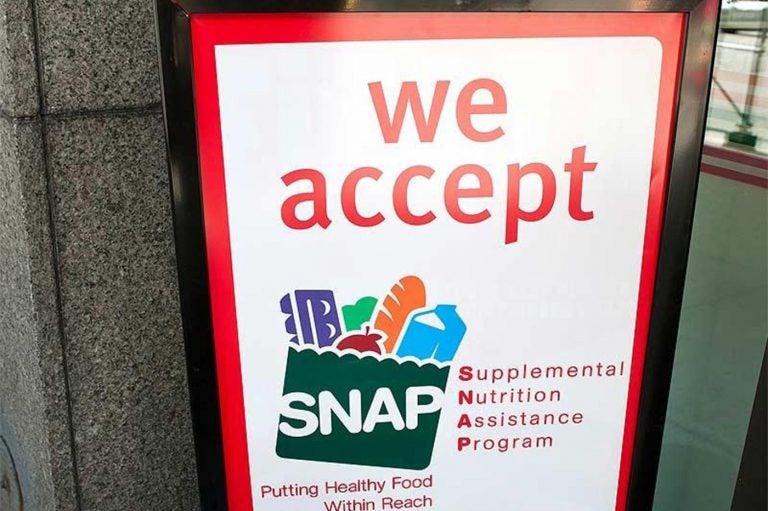America’s poverty rate falls while household incomes remain the same
Poverty in America declined last year, continuing a trend that began in 2014.

A sign indicates a store that accepts the Supplemental Nutritional Assistance Program or SNAP, the official name of the food stamp program. (File photo/The Columbus Dispatch/TNS)
This article originally appeared on The Philadelphia Inquirer.
—
Poverty in America declined last year, continuing a trend that began in 2014.
Between 2017 and 2018, however, the median household income remained basically unchanged, while the number of Americans without health insurance increased significantly.
Such was the mixed bag of findings in much-anticipated reports released Tuesday by the U.S. Census Bureau that examined economic data last year. The figures did not include information on poverty levels in cities and counties; that report is due out on Sept. 26.
Although some of the numbers appeared hopeful, poverty experts saw cracks and caveats among the flood of good-news statistics. It caused Kathy Fisher, policy director of the Greater Philadelphia Coalition Against Hunger, to wonder: “How many people are really making progress?”
The poverty rate fell 0.5 percentage points, from 12.3% in 2017 to 11.8% last year, the reports showed.
That means the number of Americans living in poverty declined from 39.5 million to 38.1 million. The federal poverty level for a family of three in 2018 was $20,780 (it’s currently $21,330).
In the reports, the 2018 median household income was listed as $63,179, not statistically different from the 2017 level of $62,626.
The Trump administration found much to praise in the reports. In a statement from the Council of Economic Advisers, White House officials on Tuesday touted the Trump administration’s hand in lowering poverty and helping Americans.
“Before today’s release of the latest Census data, it was already clear that the growing economy was adding millions of jobs and pushing up wages for American workers,” the statement said.
“We now have evidence that the gains were particularly important in 2018 for those typically left behind: Income increased the most for lower-income families. Inequality fell. Poverty fell … unemployment has reached record lows, millions of jobs have been added, and wages have risen. It can no longer be denied that some of the biggest beneficiaries are Americans who have been disadvantaged historically.”
A widely remarked-upon bullet point of the poverty decrease was the drop in the poverty rate for people living in female-headed households, from 28.5% to 26.8% — the lowest level since record-keeping began in 1959.
That’s movement in the right direction, Fisher said. But she added, “That’s still unacceptably high.”
At the same time, childhood poverty declined from 17.4% in 2017 to 16.2% in 2018, a slide from 12.8 million youngsters under age 18 to 11.9 million.
The nation’s long economic expansion is the reason for the improved numbers, analysts said. H. Luke Shaefer, director of Poverty Solutions at the University of Michigan, said the reports’ findings included “good signs.”
But, he hastened to add, “While I’m encouraged, people living at the bottom are still facing a lot of challenges. There’s a lot of work to be done.”
As Joel Berg, CEO of the nonprofit Hunger Free America, observed, the number of Americans living in poverty is still unacceptably high.
“In contrast,” he said, “the wealthiest 400 Americans had a combined worth of $2.9 trillion in 2018, or $76,115 for each of the 38.1 million Americans in poverty.”
Of further concern to experts was the news that 8.5% of Americans, or 27.5 million, lacked health coverage in 2018, up from 7.9% in 2017. That means nearly two million more people were uninsured in 2018 than in 2017.
Various experts, such as Robert Greenstein, founder and president of the left-leaning Center on Budget and Policy Priorities, say the change in health care is due in part to efforts by the Trump administration to weaken public health coverage.
Along with the poverty and insurance reports, the Census Bureau on Tuesday also released the so-called Supplemental Poverty Measure. This yardstick looks at poverty in a different way, adding nuance to the overall data, and it shows, according to experts, that the decrease in poverty rates may not be as simple as it seems.
Considered more accurate than the traditional method of gauging poverty, the supplemental measure takes into account the benefits received by people in poverty — food stamps, earned income tax credits (EITC), special aid to young mothers, school meals, among other programs. For example, according to the Census report, the measure showed that the EITC lifted 7.9 million Americans out of poverty in 2018; food stamps raised 3.1 million; and rental assistance moved three million above the poverty line.
On the other side of the ledger, the supplemental measure also calculates how much a family has to pay out to survive, including health-care costs, taxes, child care, and housing.
According to the supplemental measure then, the poverty rate in 2018 was 13.1%, as opposed to 11.8%. The figure was not statistically different than the supplemental rate of 13% in 2017.
To analysts such as Deborah Weinstein, executive director of the nonprofit Coalition on Human Needs, the combination of the unchanged supplemental poverty measure and the median income, which also did not change, is worrying.
“These results are worse than we expected,” she said. “It looks like Americans in 2018 were not sharing enough in economic growth.”
For instance, Weinstein said, rents across America increased 3.5% between 2017 and 2018, and income did not keep up. “It shows,” she said, “that people are living on the edge.”
Putting it more bluntly, Olivia Golden, an executive director at the nonprofit Center for Law and Social Policy, said, “What you have is a picture of fairly stagnant living standards.
“And with health insurance numbers getting worse, the overall picture is not as rosy as the decline in poverty suggests.”
 The Inquirer is one of 21 news organizations producing Broke in Philly, a collaborative reporting project on solutions to poverty and the city’s push toward economic justice. See all of our reporting at brokeinphilly.org.
The Inquirer is one of 21 news organizations producing Broke in Philly, a collaborative reporting project on solutions to poverty and the city’s push toward economic justice. See all of our reporting at brokeinphilly.org.
WHYY is your source for fact-based, in-depth journalism and information. As a nonprofit organization, we rely on financial support from readers like you. Please give today.




